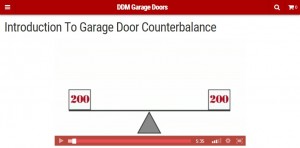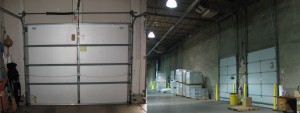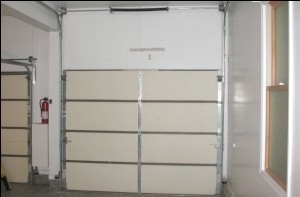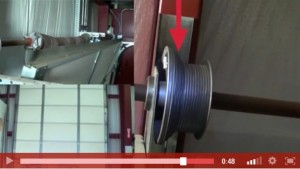Posted November 3rd, 2015 at 11:23 am by Dan Musick

At DDM Garage Doors, we go to great lengths to help our customers select the correct springs. Sometimes customers order the wrong springs, the garage door doesn’t balance, and they contact us for help.
On standard lift and industrial vertical lift garage doors like you find in businesses and homes, there are three common scenarios. This depends on whether the springs are correct, too weak, or too strong. The principles in this blog apply to both torsion and extension spring doors.

Correct Springs
If you have the correct springs, and if you wind torsion springs the correct number of turns, or if you have extension springs and you stretch the springs the correct length, the door will stay on the floor when closed, it will stay in the center, and it will stay up when opened fully. The door will be easy to open and close throughout its travel.
On the other hand, if the springs are not wound or stretched enough, the door will be heavy, and it will not stay halfway or open without being supported. If the door is opened completely, the cables will often come off the drums or pulleys. If the springs are over-wound or overstretched, the door will open by itself. It will not stay on the floor nor halfway, but it will stay open. However, the door will be hard to close. If you have the correct springs, you can balance the garage door simply by adjusting the torsion springs or the location of the S-hook if you have extension springs. Watching our YouTube Video may also be able to help.
Strong Springs
If your springs are too strong, and if you wind the springs the correct number of turns or adjust the cables and S-hooks correctly, the door will not stay on the floor when closed. It will usually not stay in the middle when opened halfway. However, it will stay up when opened fully. If you remove too much tension to get the door to stay on the floor when closed, the cables will probably come off when you reopen the garage door. The general solution is to replace the spring or springs. One option is to add weight to the door to balance it.
Weak Springs
If your springs are too weak, and if you adjust the springs correctly, the door will stay on the floor when closed. However, it will be heavy and hard to open. It will usually not stay in the middle when opened halfway, but it will usually stay up when opened fully. The general solution is to replace the springs.
Options Available
One option is to add tension to the springs. For example, if the door weighs 40 pounds on the floor, you can adjust the torsion springs to reduce the weight to 20 pounds. But even so, closing the door will still require an extra 20 pounds of pull or opener force. This will also shorten the life, usually by as much as 45% with just one turn of spring tension added or a few inches of stretch. It may even reduce their life by 25% with the addition of a half turn.
Here’s how the door will work if it is 40 pounds out of balance. For example, if the springs lift 40 pounds less than is needed. You can adjust the springs, so the door is 20 pounds heavy on the floor and 20 light when open. If you stand on a scale, you will find that you lose 20 pounds when pulling down on the door. When you lift the door, you gain 20 pounds. Without adding extra spring tension, you will gain 40 pounds when you start lifting the door.

High lift garage doors can be more difficult to balance because of the timing of the cable and drum. The cable must be the proper length, and you must install it properly. Make sure that the cable begins wrapping on the flat portion of the drum as the top roller of the door begins rolling on the horizontal track as the door opens. If a high lift door does not balance properly, it is best to first check the cable timing.

One of our customers, who had purchased a high lift conversion kit, wrote to us. He was asking what to do because his door lifted by itself after winding the springs.
Here is what I wrote:
“You either have the wrong springs, too many turns on the springs, or the wrong cable timing.
First, check to make sure the cables wrap around the outside grooves of the drums and don’t skip any grooves.
Second, raise the door and see if it is hard to pull down. If so, remove spring tension until the door is easy to close and then see if it will stay on the floor.
In the process of adjusting the springs, if the door won’t stay up by itself and also down by itself, you probably have the incorrect springs.”
Another possibility for an imbalance is if the installation of the springs is backward and wound the wrong direction. The garage door will open a few inches and then bind. Forcing the door up causes the cables to loosen. In our Torsion Spring Replacement Instructions and Video, we recommend marking the shaft beyond the winding cones to confirm the installation of the springs is correct.
I trust this helps with questions you may have.
This entry was filed under How Garage Doors Work, Technical Support. You can follow any responses to this entry through the RSS 2.0 feed. You can skip to the end and leave a response. Pinging is currently not allowed.


Leave a Reply